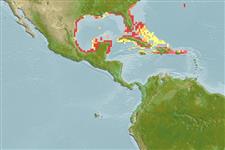Environment: milieu / climate zone / depth range / distribution range
Ecología
marino demersal; no migratorio; rango de profundidad 0 - 10 m (Ref. 52034). Subtropical; 33°N - 17°N, 99°W - 64°W
Western Atlantic: Bermuda, southern Florida (USA), Bahamas and the entire Gulf of Mexico.
Length at first maturity / Tamaño / Peso / Age
Maturity: Lm 2.1 range ? - ? cm
Max length : 5.0 cm TL macho / no sexado; (Ref. 7251); edad máxima reportada: 1.00 años (Ref. 12238)
Espinas dorsales (total) : 0; Radios blandos dorsales (total) : 12.
Shallow grass flats, especially in association with Zostera and other seagrass; periodically found in floating vegetation. Diurnal, males more site faithful than females. Ovoviviparous (Ref. 205). The male carries the eggs in a brood pouch which is found under the tail (Ref. 205). Specimens lose their skin filaments in aquaria (Ref. 30915). Has been reared in captivity (Ref. 35420). Maximum depth reported taken from Ref. 128812.
Monogamous mating is observed as both obligate and genetic (Ref. 52884). Male carries the eggs in a brood pouch (Ref. 205). Female transfers all the eggs in the ovary to the brood pouch of the male (Ref. 1284).
Lourie, S.A., R.A. Pollom and S.J. Foster, 2016. A global revision of the seahorses Hippocampus Rafinesque 1810 (Actinopterygii: Syngnathiformes): taxonomy and biogeography with recommendations for further research. Zootaxa 4146(1):1-66. (Ref. 115213)
IUCN Red List Status (Ref. 130435)
Threat to humans
Harmless
Human uses
Pesquerías: escaso valor comercial
Herramientas
Special reports
Download XML
Fuentes de Internet
Estimates based on models
Preferred temperature (Ref.
123201): 23.4 - 27.8, mean 26.6 °C (based on 229 cells).
Phylogenetic diversity index (Ref.
82804): PD
50 = 0.5000 [Uniqueness, from 0.5 = low to 2.0 = high].
Bayesian length-weight: a=0.00447 (0.00177 - 0.01127), b=3.00 (2.78 - 3.22), in cm total length, based on LWR estimates for this (Sub)family-body shape (Ref.
93245).
Nivel trófico (Ref.
69278): 3.2 ±0.5 se; based on size and trophs of closest relatives
Resiliencia (Ref.
120179): Medio, población duplicada en un tiempo mínimo de 1.4-4.4 años (tm=0.4; tmax=1; assuming Fec=100 (approx. 3 generations/year)).
Fishing Vulnerability (Ref.
59153): Low vulnerability (10 of 100).
